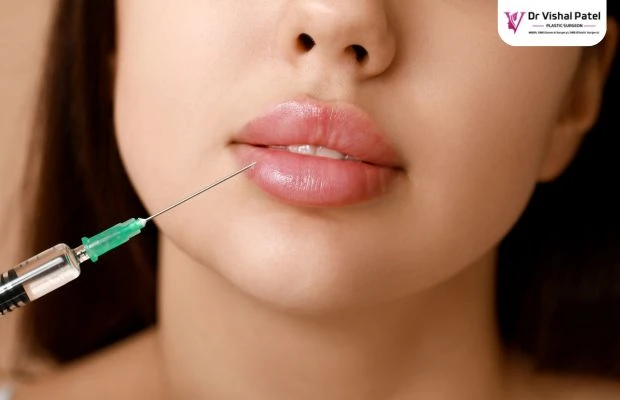
Are you tired of taking treatments over treatments for solving your hair loss problem in India ? Introducing the treatment that works, known as ‘Hair transplantation”. Hair transplant in India is an emerging field where many people are exploring the benefits, cost and getting aware of the hair transplant surgery in India.
In India, you can find hair transplant treatment availability almost in every corner of the country, from Kashmir to Kanyakumari. Yes, hair transplant in India is nowadays a very common hair restoring operation.
But, you will stumble upon one important question, how much is hair transplant cost in India ? In this detailed (I literally mean very detailed) guide on Hair transplant cost in India, we explore cost of various types of hair transplant operation in India, the cost in various cities and cost per hair graft.
We also have a good hair graft cost calculator for you in this post. So, you can use it to know the approximate cost of your hair grafting operation in India. So, let’s get started.
Before jumping to the cost, we will first explore the factors affecting the hair transplant cost in India and various Indian cities like Nagpur, Pune etc.
Factors Affecting Hair Transplant Cost in India
- Type of Hair Transplant Technique: The cost of Hair transplant in India depend on which technique you are going to opt for. Follicular Unit Transplantation (FUT), which is also called as “strip method,” is less expensive per graft than Follicular Unit Extraction (FUE). There is one more technique named Direct Hair Implantation (DHI). The price will definitely varies as per technique you choose.
- Number of Grafts Required: Price of hair transplant operation in India is directly depend of how much hair loss you have. Is it full head hair loss or just forehead or an early stage of hair loss? The formula is: More hair loss -> More number of hair grafts -> More is the price.
- Clinic Reputation and Location: Yes, this matters a lot. A well reputed, big hospital will charge you more than a small clinic. Why ? Because, they need to recover their expense on infrastructure, advertisement, marketing, salaries of employees. On the other hand, a small clinic, like Recon Plastic Surgery Clinic in Mumbai, Malad is operated by Dr. Vishal Patel solely. He don’t have added expense as like big hospital. The cost of hair transplant in Recon Plastic surgery clinic is definitely lower than big hospital chains in Mumbai.
- Surgeon’s Experience: Highly experienced hair transplant doctor in Mumbai often charge more for their services. Dr. Vishal Patel is having a good 11+ years of quality experience in Hair transplant. The cost is lower than a surgeon with 20+ years of experience. For best quality results, you just need to choose a Board Certified plastic surgeon like Dr. Vishal Patel (not just the one with very high experience).
The Best Hair Graft Calculator in India
Checkout our best hair graft calculator in India. Plan your hair restoration journey with cost factor in mind!
This hair graft calculator in India provides an estimated cost for hair transplants in India, helping you budget for your procedure. Select your state, technique, and grafts to get started.
This hair graft calculator in India provides an estimated cost for hair transplants in India, helping you budget for your procedure. Select your state, technique, and grafts to get started.
How to use our hair graft calculator:
1. Select the state where you plan to have the procedure.
2. Choose the hair transplant technique (FUT, FUE, or DHI).
3. Enter the desired number of grafts.
4. Click “Calculate” to see the estimated cost.
Hair Transplant Cost in India - A Summarized Cost
The summarized cost of a hair transplant in India across various cities can range from ₹25,000 to ₹1,50,000 (approximately $400 to $2,000 USD). This includes cost of various techniques of hair transplantation, the charges for anesthesia and the surgeon’s fee. The cost estimate may vary a bit city by city. On an average, the cost of hair transplant in India is lowest in Maharashtra state and specially for hair transplant in Mumbai.
Average Cost of Hair Transplant in India
The average cost of hair transplant in India ranges from ₹30,000 to ₹1,50,000, depending on the number of grafts and the type of procedure. For example:
1000 Hair Grafts: For 1,000 hair Grafts transplant in India, the average cost is around ₹30,000 to ₹1,00,000. This amount is enough for treatment of minor hair loss or receding hairlines. The final cost will depend on the technique used (FUE or FUT) and the clinic’s pricing structure.
2,000 hair Grafts: For upto 2000 hair graft transplant operation, the average cost in India is ₹60,000 to ₹2,00,000. This is often good for moderate hair loss or to fill in larger balding areas. Please keep in mind that the surgeon’s experience and the complexity of the procedure can influence the overall cost.
3,000 hair Grafts: For upto 3000 hair grafts, the hair plantation treatment cost ranges from ₹90,000 to ₹3,00,000. This is usually recommended for more extensive hair loss or to achieve significant density in thinning areas. Again, do remember that these are rough estimates, and it’s important to consult with a hair transplant surgeon in Mumbai for a correct estimate.
Hair Transplant Cost Per Graft in India
Now, that you have understood average cost of Hair transplant in India in above section, let’s now understand the cost of hair transplant per graft in India. Ah wait, before that you should know what is a graft? Let’s explore together.
What is a Hair Graft?
In hair transplantation operation or hair plantation surgery, a graft is a small piece of tissue that is removed from the donor area (typically the back or sides of the scalp) and transplanted to the recipient area (the balding or thinning area).
Each of this small graft contains one or more hair follicles, along with the surrounding skin and tissue that supports the follicles.
These grafts are carefully prepared and placed in the recipient area to create a natural-looking and permanent hair growth pattern.
The number of grafts needed varies depending on the extent of hair loss and the desired density to achieve in the hair plantation treatment.
Show me how the hair graft looks like!
Look at above image of hair graft. As you can see, there are multiple hair follicles which are standing over a tissue. This small tissue holding the hairs is called as Hair graft.
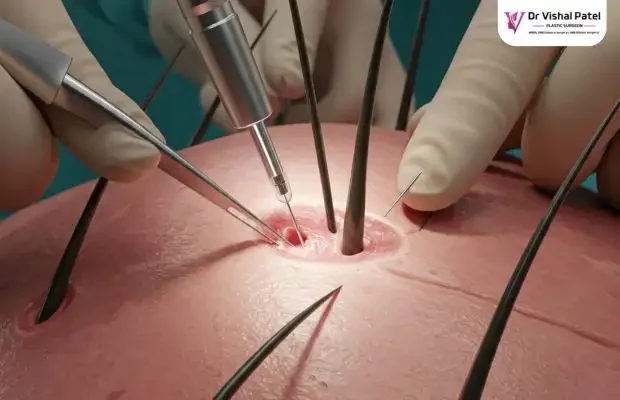
Hair Transplant Cost Per Graft in India
FUE (Follicular Unit Extraction): The FUE Hair transplant cost per graft is around ₹50 to ₹150 in India. FUE involves extracting individual follicular units directly from the scalp, leaving tiny, less noticeable scars. FUE is little more costly than FUT as FUE is more labor-intensive and requires specialized tools, it typically costs more per graft than FUT. But the advantage is that you get more precision in FUE which gives targeted placement of grafts. The thumb rule is : More precision -> Natural looking results -> a more happy you.
FUT (Follicular Unit Transplantation): The cost of FUT hair transplant per graft is ₹30 to ₹100 in India. FUT involves removing a strip of scalp from the donor area, which is then dissected to separate individual follicular units for transplantation. FUT is less costly than FUE as FUT allows for a larger number of grafts to be harvested in a single session for extensive hair loss. However, FUT leaves a linear scar at the donor site.
DHI (Direct Hair Implantation): DHI hair transplant cost per graft is ₹100 to ₹200 in India. DHI is a modified FUE technique where the extracted grafts are immediately implanted into the recipient area using a specialized tool. This minimizes the time the grafts spend outside the body which thereby helps in improving their survival rate. DHI is more precise than other 2 techniques but costs also higher than FUE and FUT price per graft in India.
3000 Grafts Hair Transplant Cost in India

A 3000 hair graft transplantation is a significant procedure. 3000 hair graft are generally required for moderate to severe hair loss treatment in India.
3000 hair graft will cover a good area and will address the hair loss problems on crown, temples and also the frontal hairlines.
The exact coverage possible with 3000 hair grafts depends on individual’s hair density and also the hair transplant surgeon’s technique. However, generally 3000 hair graft is a considerable amount and most people with noticeable baldness can opt for this.
If you are looking for achieving a full head of hair with 3000 hair graft in India, then answer is no. You may require some more graft to cover your full head. The hair transplant operation in India with 3000 hair grafts can take 3-4 hours for completion as your hair transplant doctor needs to properly place each graft in the right position.
For a 3000 grafts hair transplant in India, the cost typically ranges from ₹90,000 to ₹3,00,000. This includes hair transplant surgeon’s fees, anesthesia, and hospital charges.
4000 Grafts Hair Transplant Cost in India

For a 4000 grafts hair transplant in India, the cost typically ranges from ₹1,20,000 to ₹4,00,000.
A 4000 hair transplant operation in India is a big procedure which is recommended for people with extensive hair loss. For example, if you are the one with very high hair loss on the crown, temples and frontal hairline, then you can opt for 4000 hair graft transplant in India. The 4000 hair graft can provide substantial coverage and a noticeable improvement in hair density.
When to consider 4000 graft hair transplant ?
A 4,000-graft hair transplant is a suitable option for individuals with moderate to severe hair loss who desire a significant increase in hair density. It’s important to consult with a qualified hair transplant surgeon to determine if this is the right approach for your specific needs
Cost of 4000 graft hair transplant : The cost of a 4,000-graft hair transplant in India typically ranges from ₹1,20,000 to ₹4,00,000. The final cost will depend on several factors, including the surgeon’s experience, the clinic’s reputation, the technique used (FUE or FUT), and the location.
In addition to noting down the cost of 4000 hair transplant operation in India, you should also note below points that may influence the cost, recovery time and your overall experience with your hair transplant operation.
Recovery Time: The recovery time for a 4,000-graft hair transplant is generally longer than for smaller procedures. It may take several weeks for the transplanted grafts to stabilize and begin to grow.
Multiple Sessions: In some cases, a 4,000-graft hair transplant may be performed in multiple sessions to minimize the impact on the donor area and ensure optimal graft survival.
Consultation: It’s essential to consult with a qualified hair transplant surgeon to discuss your individual needs and determine if a 4,000-graft procedure is the right choice for you.
5000 Grafts Hair Transplant Cost in India

A 5,000-graft hair transplant is a very big hair transplant surgery in India, majorly done for individuals with extensive hair loss. 5000 hair graft is definitely considered a large number of grafts and is often a maximum amount transplanted in a single session. As per the speed and skill of your hair transplant doctor, you might sometimes requiring multiple sessions.
Is 5,000 grafts of hair a lot? Yes, 5,000 grafts is a significant amount and can provide a dramatic improvement in hair density and coverage for those with advanced hair loss. It’s not a typical number for early hair loss.
5,000 hair grafts cost: The 5,000-graft hair transplant cost in Mumbai India can range from ₹1,50,000 to ₹5,00,000. The price depends heavily on the clinic, surgeon’s expertise, the specific technique used (FUE, FUT, or DHI), and other factors. It’s important to get consultations from multiple reputable clinics (like Recon Plastic Surgery Clinic in Mumbai Malad Near Goregaon) for accurate pricing.
When to do a 5,000-graft hair transplant: This procedure is usually considered for people with –
- Significant, advanced hair loss: Those with large bald patches or extensive thinning across the scalp.
- Stabilized hair loss: It’s important that the hair loss pattern has stabilized before considering such a large transplant. Please wait until your ongoing hair loss is stopped/stabilized and then you can opt for the procedure.
- Sufficient donor hair: A patient must have enough healthy hair in the donor area (usually the back and sides of the scalp) to provide 5,000 grafts.
Side effects of doing 5000 hair graft transplant: Some minor side effects of 5000 hair graft operation in India includes below –
- Scarring: FUT will leave a linear scar in the donor area. FUE leaves tiny dot-like scars.
- Infection: There’s a small risk of infection at the donor or recipient sites.
- Bleeding: Some bleeding is possible during and after the procedure.
- Swelling and bruising: These are common in the days following the surgery.
1500 Grafts Hair Transplant Cost in India

A 1500-graft hair transplant is a minor to medium procedure that can provide noticeable results for those experiencing hair loss.
Why should you choose 1500 Grafts hair transplant?
- Moderate Hair Loss: 1500 grafts are generally recommended for individuals with moderate hair loss, such as a receding hairline or thinning crown. With 1500 graft hair plantation, you can effectively restore density in these areas without requiring an excessive number of grafts. So, it’s not a huge number and not a small number of graft.
- Cost-Effective: If you compare 1500 hair graft transplant with 3000, 5000 hair grafts, then cost is lower here and its a budget friendly option for those who want to opt for hair transplant operation in India.
- Suitable for Different Techniques: 1500 number of grafts can be easily transplanted using various techniques like FUE, FUT, or DHI. Thus, you get flexibility based on individual needs and surgeon recommendations.
What Can’t Be Achieved with 1500 Grafts?
- Extensive Baldness: For individuals with extensive hair loss, 1500 grafts hair transplant operation in India might not be enough to achieve the desired density and coverage. You might need multiple sessions or a higher number of grafts for recovering your extensive baldness.
- Complete Restoration: A 1500-graft transplant can significantly improve hair density, it might not fully restore the original density you had before experiencing hair loss.
Cost of 1500 Grafts with various Hair transplant techniques –
- FUT (Follicular Unit Transplantation): This traditional method involves removing a strip of scalp from the donor area, resulting in a linear scar. It is generally less expensive than FUE. The cost of 1500 hair graft plantation is near around Rs. 67,500 to Rs. 75,000 with FUE technique in India.
- FUE (Follicular Unit Extraction): This minimally invasive technique involves extracting individual hair follicles from the donor area, leaving no linear scar. It is typically more expensive than FUT. The cost of FUE hair transplant using 1500 hair graft is near around Rs. 75,000 to Rs. 90,000.
- DHI (Direct Hair Implantation): This advanced technique uses a special tool to implant hair follicles directly into the recipient area, offering precise placement and potentially faster healing. It is usually the most expensive option. The cost of DHI hair transplant in India with 1500 hair graft is around Rs. 82,500 to Rs. 90,000.
Stem Cell Therapy for Hair Loss Cost in India

Stem cell therapy for hair loss is a regenerative approach that uses stem cells to stimulate hair growth. The Stem cells technique for hair restoration works using growth factors derived from stem cells. The growth factors are introduced into the scalp to encourage the regrowth of existing hair follicles or potentially generate new ones.
Stem cell technique for hair restoration may take time to show noticeable results, and the amount of hair regrowth can vary person to person.
The cost of stem cell for hair regrowth is highly variable clinic to clinic. There is no standardization. Topical stem cell products are less expensive, while clinical stem cell therapies for hair loss involves injections. The cost of injections for stem cell therapy can range from Rs. 10000/- to Rs. 1,00,000. There’s less standardization in pricing compared to hair transplants cost in India.
PRP Injection Hair Cost in India vs Hair Transplant Cost

PRP (Platelet-Rich Plasma) therapy and hair transplants are both popular options for hair restoration. However, these 2 differ significantly in their approach and cost. Here’s a comparison by Dr. Vishal Patel –
PRP injection therapy for hair loss in India typically costs between ₹4,500 to ₹15,000 per session. You might need multiple sessions of PRP treatment cost like 3-6 sessions in interval of few weeks. With this, the total cost range of PRP hair injection treatment in India from ₹13,500 to ₹90,000.
PRP treatment for hair loss is good for patients with early-stage hair loss or it can be done as a complementary treatment after a hair transplant operation in India.
PRP treatment for restoring hair loss is a minimally invasive, while hair transplant operation is a surgical procedure.
PRP treatment for hair regrowth stimulates hair growth, while hair transplant physically moves existing hair from donor area to the area where you want to increase hair growth.
PRP treatment for hair loss cost is per session, and multiple sessions are needed. While hair transplant cost is for the procedure itself which includes surgeon’s fees, anesthesia and other expenses during the surgery.
Biofibre Hair Transplant Cost in India
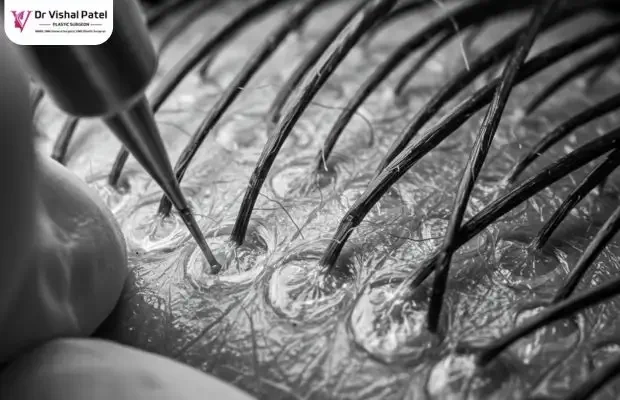
Biofibre hair transplant in India is also known as artificial hair implant or synthetic hair transplant. Biofibre hair transplant involves usage of synthetic hair fibers which are implanted into the scalp to create the appearance of thicker hair. It’s important to understand that these are not real hairs and this is different from a traditional hair transplant using your own natural hair follicles.
These fibers are designed to mimic the look of natural hair. It’s often presented as a quick solution for hair loss.
Biofibre hair transplant side effects are a significant concern. Because the implanted hairs are artificial, the body may react to them as foreign objects. Potential side effects of biofibre hair implant include:
- Infections: Risk of infection at the implantation sites.
- Inflammation: The scalp may become inflamed or irritated.
- Rejection: The body may reject the artificial fibers, leading to hair loss.
- Scarring: Scarring can occur at the implantation sites
Dr. Vishal Patel is a well known biofibre hair transplant specialist in Mumbai, at his Recon Plastic Surgery Clinic in Mumbai near Goregaon & Malad. He is experienced in various hair restoration techniques, including Biofibre hair implants in Mumbai, FUE, FUT & DHI.
Cost of Biofibre Hair Implant in Mumbai is around Rs. 40 to Rs. 120 per fibre. It is important to visit your biofibre hair transplant surgeon in Mumbai with an appointment and get the correct estimate.
The cost of a Biofibre hair implant in Mumbai India can vary depending on several factors, including the clinic, the expertise of the biofibre hair implant doctor, the extent of hair loss, and the number of Biofibre fibres required. On average, the cost of biofibre hair implant ranges from ₹50 to ₹150 per fibre. For a full procedure, the total cost may range between ₹50,000 to ₹2,00,000, depending on the number of fibres implanted.
Hair Transplant Cost in India for Male
The cost of hair transplant for males in India ranges from ₹30,000 to ₹1,50,000, depending on the number of grafts and the type of procedure.
Female Hair Transplant Cost in India
Female hair transplants are becoming increasingly common in India as more women are now turning towards hair transplant operation to address their hair fall problem. The basic principles of hair transplantation apply to both men and women, there are some key differences and considerations specific to female hair loss as follows –
Diffuse Thinning: Women often experience diffuse thinning across the scalp rather than a receding hairline. This makes it more challenging to determine the number of grafts and design a natural-looking hairline.
Pattern of Hair Loss: Female hair loss patterns is different from male patterns. Understanding these patterns is crucial for a successful hair transplant in females in India.
Hairline Design: Creating a natural-looking hairline for women requires a delicate touch and an understanding of female facial features. This is one of important point to consider in hair transplant in females in India.
Less Shaving: Women don’t need to shave their heads completely, or only a small area needs to be shaved, depending on the technique and the area being treated
Female hair transplant costs in India can range from approximately ₹50,000 to ₹2,50,000 as the number of grafts required for female is considerably higher than a hair transplant operation for males in India.
Beard Hair Transplant Cost in India
The cost of beard hair transplant in India ranges from ₹50,000 to ₹1,50,000, depending on the number of grafts required.
Beard hair transplants is a new thing in market. It is becoming increasingly popular in India as more men want to achieve fuller, more defined beards. The hair transplant operation for beard in India involves transplanting hair follicles from a donor area (usually the scalp) to the beard area to fill in patchy spots. Sometimes, the surgeon may advise or patient asks to create a completely new beard. The cost of beard hair transplant in India ranges from ₹40,000 to ₹2,00,000.
Eyebrow Hair Transplant Cost in India
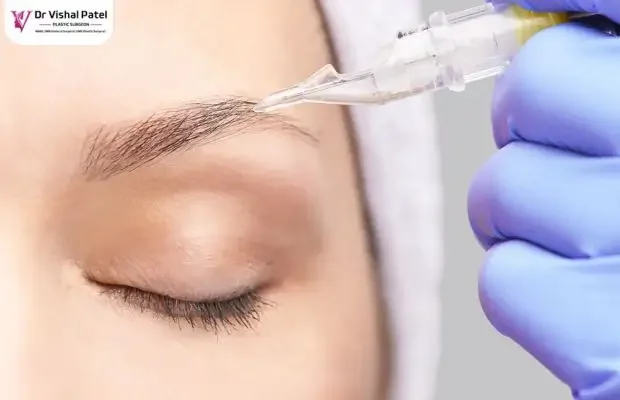
The cost of eyebrow hair transplant in India ranges from ₹30,000 to ₹1,00,000, depending on the number of grafts and the surgeon’s expertise.
Cheapest Hair Transplant Cost in India
The cheapest hair transplant cost in India starts at ₹30,000 for small procedures like 1,000 grafts. However, it’s important to choose a reputable clinic to ensure safe and effective results.
Full Head Hair Transplant Cost in India
A “full head” hair transplant in India is a comprehensive hair restoration operation which covers a significant portion of the scalp. In full head hair transplant, the surgeon will extensive hair loss, including the hairline, the top (vertex), and often the crown area.
It doesn’t mean every single hair follicle on the head is transplanted – that’s not realistically possible.
The cost of a full head hair transplant in India ranges from ₹1,00,000 to ₹5,00,000, depending on the number of grafts and the type of procedure.
Number of Grafts for a "Full Head" hair transplant:
The number of grafts required for a “full head” hair transplant depends on the individual’s degree of hair loss (measured using Norwood scale), the desired density, and the area to be covered. On an average, total number of grafts required for full head hair restore operation ranges from 3000 to 6000 grafts or even more in some cases.
Cost for Full Head Transplant in India:
Due to the wide range of grafts involved, the cost of a full head hair transplant in India can vary as per -graft pricing. So, a hair transplant procedure which involves 3000-6000 grafts could cost anywhere from ₹1,00,000 to ₹4,00,000.
Hair Transplant Cost in India and Options
India offers a range of hair transplant options, including FUE, FUT, DHI, and PRP therapy. The cost varies depending on the technique and the number of grafts required. Let’s look at various cities which can be a better option for hair transplant operation in India. This includes Kolkata, Patna, Mumbai, Nagpur.
Hair Transplant Cost in Kolkata

The cost of hair transplant in Kolkata ranges from ₹30,000 to ₹1,50,000, depending on the number of grafts and the type of procedure.
Kolkata, the “City of Joy,” is now having a growing number of clinics specializing in hair transplant procedures. As a major city in Bengal state of India, Kolkata offers a range of options for hair transplant operations.
Generally, the price of hair transplantation in Kolkata can range from ₹25,000 to ₹1,50,000 or more. This range depends on the number of grafts, the chosen technique.
Hair Transplant Cost in Mumbai
Mumbai is the city of hope, place of dreams. It is also a best center for hair transplant procedures in India. Various reputable plastic surgery clinics provide various types of hair transplant in Mumbai. Dr. Vishal Patel’s Recon Plastic Surgery Clinic is one of it which provide low cost hair transplant in Mumbai with guaranteed precision and ensuring patient’s satisfaction.
Generally, the cost of hair transplant in Mumbai ranges from ₹30,000 to ₹2,00,000 or more. This broad range is influenced by the number of grafts needed, the chosen technique (FUT, FUE, or DHI), the clinic’s facilities. For detailed figures, checkout our blog post on hair transplant cost in Mumbai.
Hair Transplant Cost in Patna

Patna is the capital of Bihar is slowly now becoming a destination for medical procedures, including hair transplants. The cost of a hair transplant in Patna is very affordable as compared to major cities. However, it’s essential to research and choose a reputable clinic with experienced surgeons to ensure quality results.
The final cost will depend on factors such as the number of grafts required, the chosen technique, the clinic’s infrastructure, and the surgeon’s expertise. But still, a hair transplant in Patna might range from approximately ₹20,000 to ₹70,000. So, yes, it’s affordable.
Hair Transplant Cost in Nagpur

The cost of hair transplant in Nagpur ranges from ₹30,000 to ₹1,00,000, depending on the number of grafts and the type of procedure.
Nagpur is a district place in Maharashtra and sub-capital city. It is a growing hub for medical tourism, including hair transplant operations in Maharashtra. Several clinics in the city offer FUT, FUE, and DHI techniques.
The cost of a hair transplant in Nagpur ranges from ₹30,000 to ₹1,00,000. This cost range depends on the number of grafts needed, the technique used (FUT, FUE, or DHI), the clinic’s reputation, and the surgeon’s expertise
Conclusion - Hair transplant cost in India
The hair transplant cost in India varies depending on the type of procedure, number of grafts, and clinic reputation. Whether you choose FUE, FUT, or DHI, it’s important to consult a trusted surgeon to ensure the best results. Ready to restore your hair? Call us today to book your consultation.
Dr. Vishal Patel - Best Plastic Surgeon in Mumbai


Dr. Vishal Patel is widely recognized as the best plastic surgeon in Mumbai, with over a 11+ years of experience in cosmetic and reconstructive surgery. Known for his expertise, compassionate care, and exceptional results,
Dr. Patel has helped 10000+ patients achieve their aesthetic goals and regain their confidence with successful plastic surgeries in Mumbai. Dr. Patel specializes in a wide range of advanced plastic surgery procedures, including:
Breast Augmentation in Mumbai
Mommy Makeover in Mumbai
He is a founder of Recon Plastic Surgery Clinic in Mumbai near Malad West.
Get Guaranteed Discount on Hair transplant cost in India
Get up to 30% Off on consultation and surgery fees with Dr. Vishal Patel – A Board Certified Plastic Surgeon in Mumbai.
Book your appointment now!.
Step 1
Fill the form
Step 2
Fix Your Time Slot
Step 3
Mention about offer at Reception
Contact Us for Best Hair Transplant Cost in India
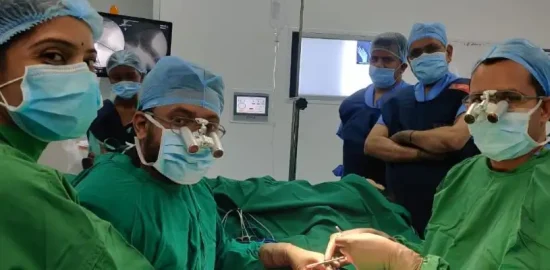
Grab Up To 30% Off Discount on Hair Transplant cost in India
9004983316
Visit Us for Best Hair Transplant Cost in India
Our Address in Malad, Mumbai
Recon Plastic Surgery & Physiotherapy Clinic,
302, Corporate Corner, Next to Dalmia College, Mandlik Nagar, Sunder Nagar, Malad West, Mumbai, Maharashtra 400064


